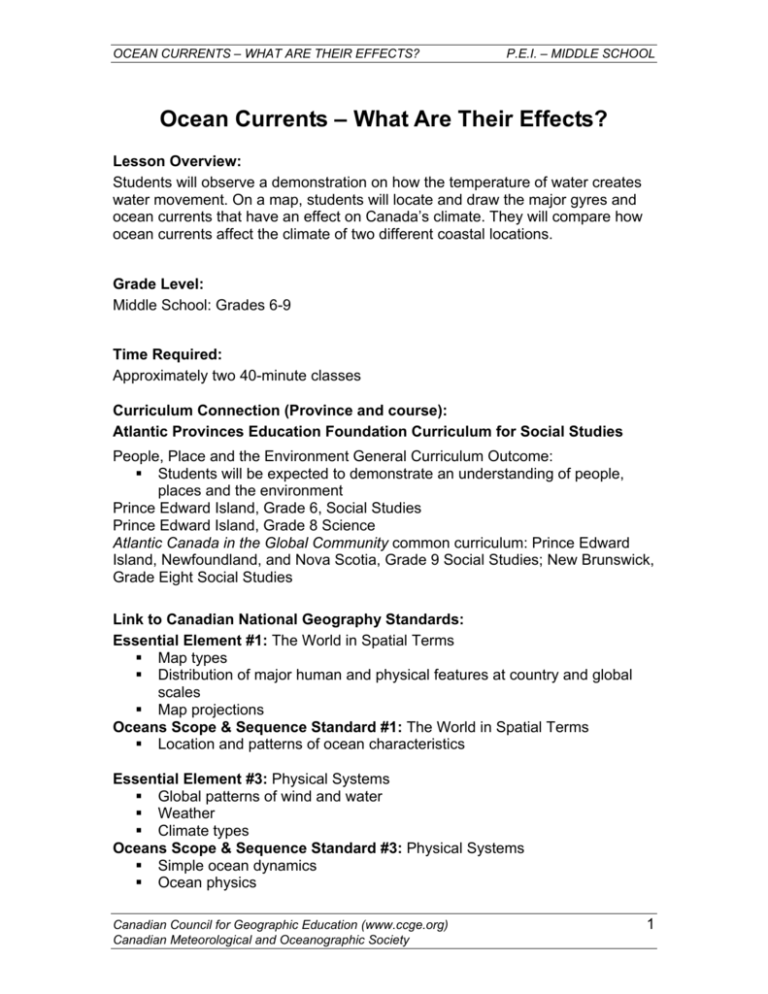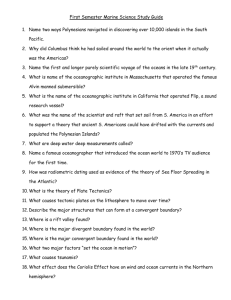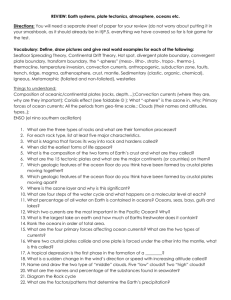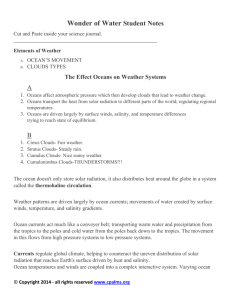Ocean Currents – What Are Their Effects?
advertisement

OCEAN CURRENTS – WHAT ARE THEIR EFFECTS? P.E.I. – MIDDLE SCHOOL Ocean Currents – What Are Their Effects? Lesson Overview: Students will observe a demonstration on how the temperature of water creates water movement. On a map, students will locate and draw the major gyres and ocean currents that have an effect on Canada’s climate. They will compare how ocean currents affect the climate of two different coastal locations. Grade Level: Middle School: Grades 6-9 Time Required: Approximately two 40-minute classes Curriculum Connection (Province and course): Atlantic Provinces Education Foundation Curriculum for Social Studies People, Place and the Environment General Curriculum Outcome: Students will be expected to demonstrate an understanding of people, places and the environment Prince Edward Island, Grade 6, Social Studies Prince Edward Island, Grade 8 Science Atlantic Canada in the Global Community common curriculum: Prince Edward Island, Newfoundland, and Nova Scotia, Grade 9 Social Studies; New Brunswick, Grade Eight Social Studies Link to Canadian National Geography Standards: Essential Element #1: The World in Spatial Terms Map types Distribution of major human and physical features at country and global scales Map projections Oceans Scope & Sequence Standard #1: The World in Spatial Terms Location and patterns of ocean characteristics Essential Element #3: Physical Systems Global patterns of wind and water Weather Climate types Oceans Scope & Sequence Standard #3: Physical Systems Simple ocean dynamics Ocean physics Canadian Council for Geographic Education (www.ccge.org) Canadian Meteorological and Oceanographic Society 1 OCEAN CURRENTS – WHAT ARE THEIR EFFECTS? P.E.I. – MIDDLE SCHOOL Geographic Skill #2: Acquiring Geographic Information Use maps to collect and/or compile geographic information Geographic Skill #3: Organizing Geographic Information Prepare graphs to organize and display geographic information. Additional Resources, Materials and Equipment Required: Teacher Demonstration: - One large clear container (such as an aquarium) with room temperature water to a depth of about 25 cm - Food colouring - red and blue -Two 250 ml Erlenmeyer flasks - Hot water and cold water - A class set of red and blue colour pencils (other colours will be needed for the student graph) TV/VCR Oceans in Motion (video, approx. 24 minutes) by National Geographic Society, 1998. This video shows the impact of ocean currents around the world. Black line world map (available from following websites) http://atlas.gc.ca/site/index.html http://www.edselect.com/maps.htm http://www.graphicmaps.com/aatlas/moremaps.htm http://www.nationalgeographic.com/maps/ Student access to encyclopedias or the Internet to complete the map. Websites that can be used to access information for the maps are: http://www.glacier.rice.edu/oceans/4_windcirculation.html http://oceancurrents.rsmas.miami.edu/ (website is still being worked on) Graph paper, colour pencils and rulers To get average temperatures for the graphs, use: http://www.climate.weatheroffice.ec.gc.ca/climate_normals/index_e. html Other helpful/related websites: http://www.physicalgeography.net/fundamentals/8q.html http://earth.usc.edu/~stott/Catalina/Oceans.html http://school.discovery.com/curriculumcenter/oceans http://school.discovery.com/quizzes20/curriculumcenter/CC_Ocean s.html (online ocean quiz) Main Objective: To become familiar with the location of the major gyres and ocean currents and to see how they can affect the climate of different regions. Canadian Council for Geographic Education (www.ccge.org) Canadian Meteorological and Oceanographic Society 2 OCEAN CURRENTS – WHAT ARE THEIR EFFECTS? P.E.I. – MIDDLE SCHOOL Learning Outcomes: By the end of the lesson, students will be able to: Explain how temperature differences in water cause water movement Locate and map the ocean gyres and major ocean currents around Canada Examine and graph how currents affect climate. The Lesson: Conclusion Lesson Development Introduction Teacher Activity Divide the class into groups of two or three. The teacher will demonstrate how warm water and cold water move to cause convection currents. (See “Teacher Demonstration” below) Student Activity In small groups, students will hypothesize the movement of the hot and cold water. Students can sketch a series of drawings to represent what happens during the teacher’s demonstration. Students explain how temperature differences create water movement. Give each student a blank copy of a world map (see web sites above to get a copy) and a copy of the Student Worksheet. Using the websites given on the worksheet, students will label the oceans and gyres on the world map. Inform students that they are to accurately and neatly label their maps. The currents and gyres are to be colour coded. Students will label the major currents in the ocean to which they live closest. Have the students choose two Canadian coastal locations. Using information from the Environment Canada website, students are to draw a line graph to compare the average monthly temperatures of their chosen locations. Remind them that their graphs will be marked on neatness, accuracy and completeness (see Ocean Currents Evaluation Rubrics). Show the video, Oceans in Motion. Canadian Council for Geographic Education (www.ccge.org) Canadian Meteorological and Oceanographic Society Using the website on the worksheet, students will choose two coastal locations near two different oceans. They will construct a line graph to compare the average temperatures of these two locations. Students will try to draw conclusions as to the role of currents in the temperature differences between the locations. Have the students write a brief summary of the video to hand in. 3 OCEAN CURRENTS – WHAT ARE THEIR EFFECTS? P.E.I. – MIDDLE SCHOOL Teacher Demonstration: With a partner or in small groups, have the students hypothesize what will happen when a flask of red hot water is placed on one side of a container of room temperature water and a flask of blue cold water is placed on the other side. Point out to the students that the water in the container should not be moving. The students will make a series of quick sketches using a red and blue pencil that shows how the water movements differ because of their temperature (and because the cold water is more dense). They can have 5-6 pre-made sketches of the container in their notebooks. The sketches should be labeled in one minute intervals, starting at 0 minutes. When enough time has passed for the students to see how hot and cold water moves differently, they can explain in their own words how differences in water temperature play a role in creating currents. A variation could be a similar demonstration with different salinities of water instead of different temperatures. Lesson Extension: Students could prepare various types of projects to present to the class. Possible ideas include: a poem, song, play, cartoon, puppet show or story about the formation of currents; or a poster that illustrates the main ocean currents that affect the climate of the Canadian coast closest to them. Using the website http://www.cbc.ca/stories/2003/07/22/rubber_ducks030722, map the locations of where rubber ducks were found. Create an “Ocean Scrapbook”. Include any articles and pictures from newspapers, magazines and web sites about currents, tsunamis, ocean research and discoveries and marine organisms. Assessment of Student Learning: Completion of “Ocean Currents Evaluation Rubrics”: Students will have a hypothesis and sketches related to the teacher demonstration. They will also have a summary (conclusion) from the demonstration that explains how temperature causes the water to move. Students will have a completed map of gyres and/or currents that can be marked. A quiz on the map could also be given. Students will produce a graph that compares the climates of two coastal locations. Students will have a journal entry summarizing the video. Canadian Council for Geographic Education (www.ccge.org) Canadian Meteorological and Oceanographic Society 4 OCEAN CURRENTS – WHAT ARE THEIR EFFECTS? P.E.I. – MIDDLE SCHOOL Student Worksheet: Ocean Currents - What are Their Effects? 1. In a group of two or three, form a hypothesis as to what will happen to the hot and cold water that your teacher will be using in the demonstration. 2. Individually, sketch six drawings of the container filled with room temperature water. These will be your templates to sketch what happens during the demonstration. Label each of these templates 0 minutes, one minute, two minutes, three minutes, four minutes and five minutes. Using a red and blue colour pencil, draw what happens to the red (hot) and blue (cold) water at each one-minute interval. 3. In a brief paragraph, summarize how the hot and cold water moved. How would this help to create ocean currents? 4. Using the following websites, label the world’s oceans and the ocean gyres. Use a different colour for each gyre. Label the major currents that are found in the ocean that you live closest to. http://www.glacier.rice.edu/oceans/4_windcirculation.html http://oceancurrents.rsmas.miami.edu/ 5. Log on to: http://www.climate.weatheroffice.ec.gc.ca/climate_normals/index_e.html. Select two cities on the coasts of two different oceans. For each of your cities, locate the daily average temperature for each month. On the graph paper provided by your teacher, draw a line graph to compare the monthly temperatures of each city. Remember to label your axis (temperature in °C and months). Each city must be represented with a different colour. Your graph must have a title. Rulers are to be used. 6. What conclusion could you make about the role of ocean currents in the climates of different locations? 7. After watching the “Oceans in Motion” video, write a summary about other ways ocean currents can impact the world. 8. Submit all of your work to your teacher for assessment. Canadian Council for Geographic Education (www.ccge.org) Canadian Meteorological and Oceanographic Society 5 OCEAN CURRENTS – WHAT ARE THEIR EFFECTS? P.E.I. – MIDDLE SCHOOL Ocean Currents Evaluation Rubrics Map Content Line Graph Video Summary 1 2 3 4 Several oceans and gyres are not labeled or are not accurately placed. Most oceans and gyres are labeled. Some are not accurately placed. Currents are not labeled. Oceans, gyres and currents are accurately labeled, but could be neater. Oceans, gyres and currents are accurately land neatly labeled. Colour is used for the gyres. 1 2 3 4 Graph is completed, although not accurately. Ruler was not used. X-axis and Y-axis units are not evenly spaced. There are some accurate plots made. Ruler was used. The units are not evenly spaced. Most plots are accurately placed on graph. Ruler was used and the units are evenly spaced, there is no colour. X-axis and Yaxis are not labeled. No title on graph. X-axis or Yaxis is labeled. No title on graph. X-axis and Yaxis are labeled. No title. All plots are accurately placed and connected. Overall, the graph is neat and legible. Units are evenly spaced. Colour has been used. X-axis and Yaxis are labeled with variables and units. 1 2 3 A few facts with only a couple of spelling and grammatical errors. Brief summary with no reference to the impact of currents. Many grammatical and spelling errors. Slight reference to the impact of currents. Several spelling and grammatical errors. Canadian Council for Geographic Education (www.ccge.org) Canadian Meteorological and Oceanographic Society 4 Well thought out summary with several facts and no spelling or grammatical errors. 6









